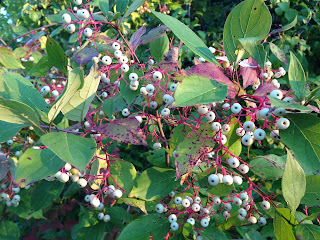Today's color is red - one that will be making more of an appearance as the calendar marches on through September toward October. This pigment can show up in different plant parts as red or red-related colors of purple or blue. In flowers, colors and patterns may attract pollinators or alert herbivores to stay away from toxins. During the growing season, leaves and stems often show more green than anything else since chlorophyll, another pigment, is readily produced to use in photosynthesis. In spring and fall with less chlorophyll production, other pigments such as the red anthocyanins or yellow xanthophylls dominate. Red anthocyanins may also act as a sunscreen to lend some protection to plants. How many shades of red can you find in your back yard?
The bright vermillion petioloes of Red Maple (Acer rubrum) caught my eye when I got out of work yesterday afternoon. Many of the leaves on this tree are already drying out and losing their greenness.
In passing, these brambles sport maroon tinted twigs. The leaves are showing a lot of end-of-the-season wear and tear.
Ruby twigs are readily apparent and striking against the white berries of Red-osier Dogwood (Cornus sericea). Note this genus' arcuate leaf veins - a great diagnostic - and the opposite leaves and buds which help identify the species.
Staghorn Sumac's (Rhus hirta) leaves are beginning to reveal crimson pigments. Staghorn Sumac is a good example of shrub vs. tree: multiple woody stems less than 3" diameter and less than 15' in height. It's also a good example of compound leaves - the bud forms at the base of the leaf on the twig, but there are no buds or swellings at the base of the leaflets.




No comments:
Post a Comment